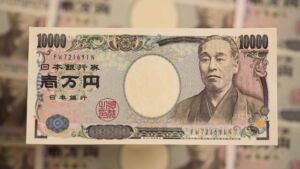There is absolutely nothing insightful or valuable about tweeting or repeating the popular narratives that circulate in mass financial media. But to illustrate the dull, boring herd mentality of financial journalists, go to Twitter and search for “Japanese yen” and you’ll find thousands of tweets comparing Yen to BTC, gold, other fiat currencies, all “inspired” by stories of a crashing Japanese yen flooding mainstream financial media as of late. But here at skwealthacademy, just as the tagline of this newsletter states, you will always find uncommon, suppressed financial truths to guide your way to profits during an uncertain, unstable investment environment, just as you will find the real information never taught in business school MBA programs to help you build wealth in my soon-to-be-launched academy that I am working round-the-clock to launch at the current time. So, after an initial cursory review of the popular Forex narrative of the moment, I’m going to tell you what currency pairs you really should be following, outside of this irrelevant Central Banker distraction, to guide you to profitable investment decisions this year.
And as a thank you to those that have become paying members of my substack newsletter, stay tuned later today, because I will providing additional buying and selling guidance on the put option strategy I discussed in the 20 April post titled “Time to Short This Stock?”, I literally waited six months for this stock to reach my price target to short it, which I provided in the article, and after providing exact specs (expiration date, purchase price, and strike price) for the option strategy, which was easily achievable that day and also the following day on 21 April, this option is now sitting on a 34.5% profit at the mid-point of yesterday’s bid/ask spread market close for this put option. Thus, my selling guidance to the downside and to the upside will now change with a significant paper profit after just two days and I believe, with a little but of luck, and an enormous amount of patience that required waiting for half-a-year for me to pull the trigger on this put option strategy for all my paying substack members (as I wanted to provide a strategy that had a very high probability of returning very significant returns as a thank you for your support), we have a decent probability of clearing a high double-digit/low triple-digit profit on this strategy upon closing it out. Now back to the topic of this article.
As I’ve stated to open this article, the crashing Japanese yen has been making financial media headlines and every financial analyst and their grandmother has jumped on this narrative. What’s causing the yen crash? What does it mean? What are the implications of the yen crash on Forex markets? And on and on and on. However, not only was the current yen crash easy to predict, it is just yet another example of the tail wagging the dog, a financial story meant to distract instead of inform. In just a minute, I will tell you what you should be following in Forex markets to understand future global asset price behavior instead of the yen.
Former clients of mine know that I’ve been professing for years the order of fiat currency collapse among the leading global currencies as follows: the yen, the euro, and finally the US dollar (by the way, I’m grateful that despite the MIB complex and Google censoring all my websites, that former clients of mine from Croatia, Italy, Argentina, Hong Kong and Korea have been able to track me down on Patreon, Substack and Rokfin, so to those from these nations that have sent me a quick note identifying yourself as such, thank you for your persistence in finding me and welcome back!) Thus, the answer to the question posed by some regarding the cause of the yen crash should be self-evident to everyone except those that follow the ridiculous, absurd narratives of mainstream financial media.
For example, even though the Japanese economy has really been in recession since 1990 for over three decades, due to absurd manipulation of key economic indicators to specifically avoid the dreaded label of being in recession (“officially” defined as two consecutive quarters of negative economic growth), the Bank of Japan and the Japanese finance ministry have been able to enter and exit recession multiple times over the past three decades. However, without the constant manipulation of data to “avoid” the negative recession label and with honest reporting of economic data, Japan may very well have been in constant recession during all those years.
With a struggling economy and a Central Banker interest rates that haven’t even been close to 1% for nearly three decades in Japan, if the yen were NOT crashing, this outcome would be the real miracle. When I lived in Thailand, no businessmen or women ever took out loans in the domestic currency of the Thai baht (at least the smart ones did not), but perpetually took out loans in yen (known as the yen carry trade) or in US dollars (known as the dollar carry trade). Why? With never-ending ZIRP (Zero Interest Rate Policies) of the Bank of Japan and the US Federal Reserve, yen or dollar borrowings were always far cheaper than domestic currency borrowings anywhere in Asia. And on the back of these nearly free loans, a massive real estate bubble formed in Thailand, that to this day, has still not popped to any significant degree, even after two-years of Covid lockdowns. A few years ago, I predicted that the Thai commercial and residential real estate bubble would burst at around the same time that the Grand Rama IX Tower, a symbol of the excess of the Thai real estate market, was completed. However, since that project has since been cancelled, perhaps in the future, I will conduct a new assessment of my projection for when the Thai RE market bubble will burst, as when it does, it is going to be a nasty event.
Japanese Yen Falling Across Multiple Currencies
As a quick glance of the below charts reveals, the Japanese yen has been crashing against multiple currencies, having dropped respectively by 9.19%, 15.75%, and a whopping 18.95% against the Euro, the Australian dollar and the US dollar between the end of last year and the current date, or in the case of the Euro, within just the past few weeks.

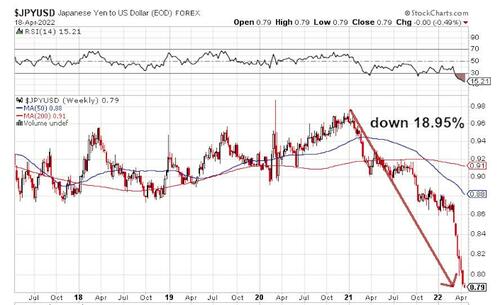
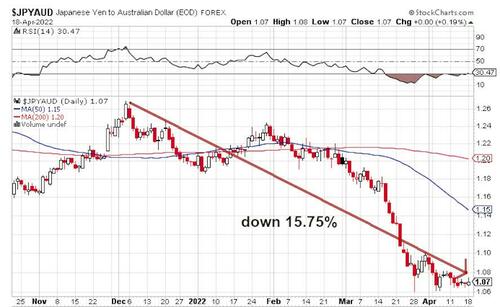
And even though the JPYEUR pair has crashed the least percentage-wise of the three pairs presented above, many people have focused on this crash because of the rapidity of this crash over the others.
Don’t Make the Mistake 99% of All Investors Make
However, don’t be misled by the above charts into assuming that those charts mean the Euro and the USD are healthy just because these currencies are very robust against the yen. Nearly all financial media speaks solely about all resources and commodities in terms of USD and Euro price, a practice which often presents a distorted, often faulty perspective about not just commodities, but about many other financial assets. For example, many crypto investors solely track gold and silver prices in US dollars, and because of this fatal flaw, they dismiss physical gold and physical silver as an integral part of their portfolio because they have zero understanding of the degree to which gold prices have soared in other fiat currencies.
Likewise, those investors that only track the currency pair discussed by financial media analysts will never understand that the above charts should never be interpreted to mean the Euro and the USD are “strong” currencies, not matter how many years it has been since they displayed such strength against the Japanese yen. Since financial media analysts only track global fiat currencies against a basket of other global fiat currencies that are most heavily weighted toward the Euro, the USD, the yen and the British pound, common sense informs us that when the media reports them as crashing, then other currencies in this currency basket will necessarily be soaring. However, “soaring” does not mean these currencies’ purchasing powers are performing in a robust manner overall in the global economy.
The Real Charts That You Need to Be Tracking
As I opened this article, everyone with a rudimentary understanding of the Forex market could have predicted the current failures in the purchasing power of the yen. But assuming the nationalistic investment perspective that I discussed above will be fatal to your financial future. What is never discussed, but what should be the focal point of all Forex discussions, is NOT how the Euro and the USD are soaring against the yen, but how they are continuing to significantly FALTER against other global fiat currencies, including against some of the weakest currencies in the entire world.
This is an incredibly important point to understand that is bizarrely completely ignored by 100% of the mainstream financial media. For example, just take a glance at the below Forex pairs to quickly realize that the Euro is not doing well. In fact, it has fallen by 10% against the Singapore dollar since mid-2021 and crashed by 15% against the Canadian dollar since mid-2020. Furthermore, it fell by more than 12% against the Swedish krona from Q1 2020 to the end of 2021. And even though it has recovered a little against the Swedish krona in recent months, I fully expect the Euro to rechallenge the recent lows it established against the Swedish krona at some point this year.

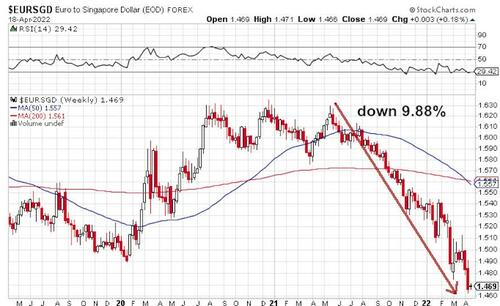

From a cursory glance of the above charts, one quickly realizes that the mass media “soaring Euro” narrative is a complete lie. And to drive my point home, take a stab at guessing the identity of the currency pair that collapsed by a ridiculous 22.53% in little over two years’ time before I reveal it to you. Don’t be so hasty to read the paragraph below the chart. Really take a stab at guessing the below currency pair before you commence reading. I’ll even provide a hint. One of the currencies is the USD.

The above currency pair is the USD: MXN currency pair. And no, the chart is not displaying the MXN peso crashing against the USD but is displaying the USD crashing against one of the weakest developing nation currencies in the entire world right now, the MXN.
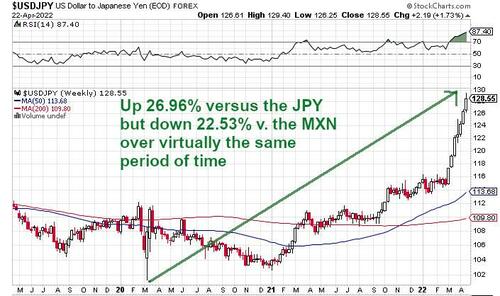
Thus, despite “soaring” against the absolute worst global fiat currency on planet Earth, the US dollar has lost nearly 23% in a year against the Mexican peso.
So, who cares if the US dollar is the strongest its been in decades against the Japanese yen if it can’t even keep pace with a historically weak Mexican peso that has devalued so much recently that its devaluation has produced the highest rates of inflation in Mexico in two decades?
Thus, the real question to ponder is if the US dollar has been collapsing against a developing world fiat currency that is collapsing in its own right, what does this bode for the future of the global currency system? In fact, in Mexico, the largest denominated coin was recently doubled from 10 pesos to 20 pesos, a strategy Central Bankers often execute in an attempt to “hide” soaring inflation, as most people associate coins with cheap values and bills with more expensive values. Thus, simply by minting larger and larger denominated coins, this act hides inflation to some degree as a high value bill is transformed into a cheap value coin. I’ve witnessed this same tactic deployed by Central Bankers in Hong Kong as well, when I was still living in Asia.

Though I have not seen the 20 MXN peso coin in wide circulation yet, mark my word, by the end of 2022/ start of 2023, the 20 MXN peso note will completely disappear from circulation. Thus, simply by minting larger and larger denominated coins, this act hides inflation to some degree as a high value bill is transformed into a cheap value coin. I’ve witnessed this same tactic deployed by Central Bankers in Hong Kong as well, when I was still living in Asia.Furthermore, to illustrate that I project things that happen many years in advance of their occurrence all the time, in this article I published more than two years ago, I discussed a contingency plan I discovered on the Bank of Mexico’s website to increase the largest denominated Mexican bank note from 1,000 pesos to 2,000 pesos. Of course, this contingency plan was to deal with perhaps a 50% devaluation in the purchasing power of the MXN as a 2,000 peso note would most likely have possessed the same purchasing power as the 1,000 peso note it replaced. The Bank of Mexico has not yet had to roll out this plan, simply because the Federal Reserve and other Central Bankers around the world have done a fine job in destroying the purchasing power of the US dollar, the Euro and all the other major global fiat currencies as well.
In that article, I noted that “the Central Bankers of Mexico continue to fib about real annual inflation rates, reporting that the yearly inflation rate in Mexico has now risen to 3.24% to start 2020. If that statistic were true and not severely underestimated, and inflation rates were low and under control as every Central Banker in the world states, except in nations in which massive inflation rates are in the high double figures and therefore undeniable, then there would be no need to openly discuss the future necessity of perhaps printing a 2,000 Mexican peso note.” I further dismissed the explanation provided by Bank of Mexico Governor Alejandro Díaz de León for opening a new banknote printing facility in Mexico, and attributed the real reason as the necessity of having “more notes in circulation to buy the same goods and services as in prior years.” Thus, no resident of Mexico that read my article two years ago should be surprised one bit that Mexico is suffering the worst inflation in two decades today, as my analysis of the Bank of Mexico’s contingency plans predicted as much.
Thus, understand the extremely low utility of mainstream financial media “information.” Most information printed in mainstream financial media publications are only meant to distract from the real issues at hand and you will never become a better investor by wasting your time reading such publications. I have delineated the real currency pairs of which we need to be aware, of which the mainstream media will never discuss in a thousand years. The mainstream financial media will never discuss the above atypical currency pairs I’ve posted above, because they destroy the propaganda narratives of a strong USD and Euro that Central Bankers perpetually distribute to the masses to keep us blind to reality and invested in assets and strategies that will never protect us from their road to serfdom.
Conclusion
Lastly, recall that I just informed you of why the USD and Euro necessarily need to remain weak for at least a few more years into the future in this just published skwealthacademy substack article. The real currency charts of concern are not the ones regarding the yen, but the ones regarding the Euro and the USD. These are the charts that illustrate that we are much closer to fiat currency collapse than anyone realizes. Secondly, these are the charts, not the ones illustrating the yen’s collapse, that should be driving your investment decisions. Finally, if my theory forwarded in the above linked article is correct, then all charts illustrating USD and Euro currency pairs should continue to show significant degradation in coming years. Thus, prepare and adjust your investment strategies accordingly.

